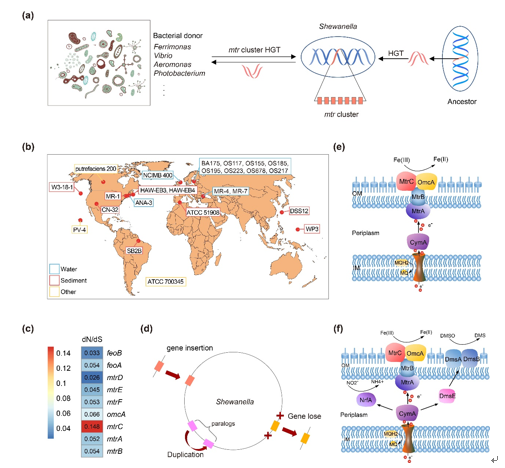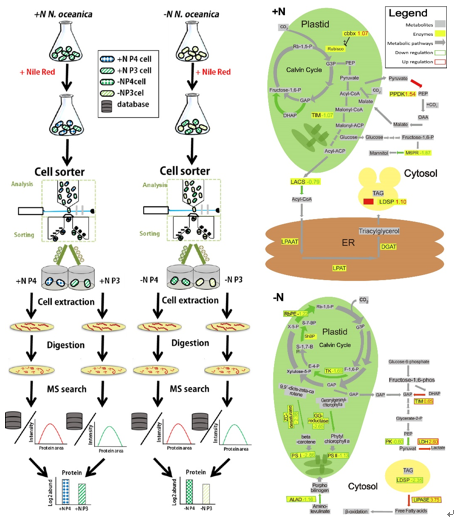(通讯员 钟朝芳)最近,8797威尼斯老品牌宁康教授团队通过先进分子生物学技术和大数据挖掘方法,研究了一系列能源微生物的功能和进化机制。2018年7月17日和2019年2月4日,施普林格•自然(Springer Nature)出版的生物能源领域顶级杂志 《Biotechnology for Biofuels》(2018年影响因子5.497)分别在线发表了生命学院宁康教授团队在产电希瓦氏菌属泛基因组和在微拟球藻积累油脂分子机制研究方面的新成果。
首先,利用基因组大数据挖掘技术,研究团队从整体水平上比较了希瓦氏菌Shewanella属的基因组组成及功能结构,揭示其基因家族的进化特征和个体菌株之间的遗传多样性,并阐明其金属还原途径和进化机制。希瓦氏菌是一类金属还原菌,在厌氧条件下能够将多种金属化合物作为呼吸作用的最终电子受体,它们可以减少有毒的重金属离子,在有毒元素和重金属的生物修复过程中可发挥关键作用。研究者利用了24株希瓦氏菌的基因组序列进行全面的泛基因组分析,获得了开放的希瓦氏菌属泛基因组,其核心基因高度保守并且在进化的过程中受到强烈的纯化选择。希瓦氏菌属开放泛基因组具有高比例(43.3%)的特有基因,反映了特有基因在个体希瓦氏菌株环境适应过程的重要作用。希瓦氏菌的基因丢失在垂直遗传过程中比基因扩张更为普遍。丰富的基因获得和丢失事件表明希瓦氏菌基因组在进化的过程中发生了大量的变异。对于该菌的铁还原途径,其相关基因簇在进化过程中受到强烈的纯化选择,并且在进化的过程中发生了部分基因丢失事件。
目前泛基因组已经广泛应用到微生物的研究中,该研究首次将希瓦氏菌属泛基因组研究的菌株数量扩大到24个,阐明希瓦氏菌属的基因多样性和金属还原途径的进化差异,将有助于进一步研究希瓦氏菌在生物修复和代谢工程中的应用。研究成果名为《Pan-genome analyses of 24 Shewanella strains re-emphasize the diversification of their functions yet evolutionary dynamics of metal-reducing pathway》,宁康教授为通讯作者,8797威尼斯老品牌博士生钟朝芳为第一作者,8797威尼斯老品牌为该文第一单位。

其次,利用单细胞分选技术和高通量蛋白组技术,研究团队探究了培养过程中微拟球藻Nannochloropsis oceanica细胞的油脂积累异质化问题。研究者利用了高通量流式细胞分选技术从缺氮处理和正常f/2培养基培养的微拟球藻细胞中分选得到不同实验处理条件下油脂积累量差异显著的亚群细胞。基于蛋白质组分析可以提供给研究者详细而全面的蛋白质表达情况,该研究中利用蛋白质组质谱分析得到了不同处理条件下,蛋白质表达上的差异,以及不同亚细胞群之间的蛋白质表达差异。通过对蛋白质表达差异与积油差异的关联性分析发现,正常f/2培养基和氮源极度缺乏的f/2培养基条件下出现积油差异的机制是不一致的。正常f/2培养条件下,高表达油脂的亚群会高表达油脂滴表面蛋白,同时也高表达丙酮糖磷酸二激酶。而在极度缺乏氮源的f/2培养条件下,针对高表达油脂细胞亚群,观察到光合作用有关蛋白质(光捕捉、叶绿素合成)表达的大幅下调,尤其是达尔文循环中有很多关键蛋白表达有所下调,比如磷酸戊酮糖差向异构酶和转酮醇酶。此外,油脂滴表面蛋白表达也有很大程度上的下调。
该研究利用流式细胞分选技术进行单细胞分选,结合蛋白质质谱分析进行细胞异质性机制研究。据了解,这是首例使用流式细胞技术在正常和极度缺乏氮源的f/2实验条件下观测并分选亚细胞群细胞的研究。为了深入研究微拟球藻积油机制的差异性,基于流式细胞技术分选亚细胞群并进行亚细胞群细胞蛋白质组学及基因组学的研究变得合理而迫切。论文《Proteomic study uncovers molecular principles of single-cell-level phenotypic heterogeneity in lipid storage of Nannochloropsis oceanica》是由8797威尼斯老品牌和德国波鸿鲁尔大学共同合作的成果,其中8797威尼斯老品牌为第一单位,生命学院宁康教授和德国波鸿鲁尔大学Ansgar Poetsch教授为通讯作者,生命学院博士研究生陈超云和德国波鸿鲁尔大学Andreas Harst博士为共同第一作者。

以上研究工作的开展,也和生命学院的双创工作相向而行,促进相关研究和教学工作协同发展。据悉,由闫云君、宁康、占艺等组成的导师团队指导的iGEM HUST-China 团队,也是以产电菌希瓦氏菌参与菌群共生发电作为2018年项目“基于微生物共生的光伏转换装置”的核心内容。该项目应用合成生物学策略提高希瓦氏菌的NADH产量和乳酸利用率,进而提高与之直接相关的产电效率,并通过引入工程光合细菌构建实现光能-化学能-电能转化的微生物产电装置。项目在2018年国际遗传工程机器大赛(iGEM)中获得全球银奖。
文章链接:
https://biotechnologyforbiofuels.biomedcentral.com/articles/10.1186/s13068-018-1201-1
https://biotechnologyforbiofuels.biomedcentral.com/articles/10.1186/s13068-019-1361-7
New Progress on the Research of Shewanella Pan-genome and the Mechanism behind the TAG Accumulation of Nannochloropsis oceanica IMET1 by Kang Ning's Team
On July 17th, 2018 and February 4th, 2019, Biotechnology for Biofuels published two investigations on the pan-genome of the genus Shewanella and the mechanism behind the TAG accumulation of Nannochloropsis Oceanica IMET1 by Prof. Kang Ning's team in the College of Life Science and Technology, Huazhong University of Science and Technology.
Shewanella is a genus of metal-reducing bacteria that can use a variety of metal compounds as the final electron acceptors of respiration under anaerobic conditions. Its ability to degrade metals plays a key role in bioremediation of toxic elements and heavy metals. To investigate the genetic diversity and clarify the evolutionary dynamics of genus Shewanella, Kang Ning's team conducted a pan-genome analysis for 24 Shewanella strains, with special focus on the evolution of metal reduction pathway. The analysis results indicate that: 1. The 24 Shewanella strains exhibited an open pan-genome structure and the core genes were constant evolving by purifying selection. 2. The high proportion (43.3%) of unique genes emphasized the heterogeneity of the genus and the important role of the variable genome in individual strains. 3. Abundant gene gain and loss contributed to functional change of Shewanella, in which the loss-of-function plays an important role in the vertical transmission. Especially, for the metal reducing pathway of genus Shewanella, the mtr-omc gene cluster evolved under strong selective constraints, with the existence of gene gain and loss, indicating a possibly metal respiratory specialization.
Pan-genome has been widely used in microbial research. For the first time, we expand the number of Shewanella strains to 24 and outline a more comprehensive and deeper profile of genus Shewanella based on pan-genome research. The elucidation of genetic diversity and evolutionary differences in metal reduction pathways guide a further study for the applications of Shewanella in bioremediation and metabolic engineering. This research is titled as "Pan-genome analysis of 24 Shewanella strains re-emphasize the diversification of their functions yet evolutionary dynamics of metal-reducing pathway", and Prof. Kang Ning hold the post as the correspondent author, Ph.D. student Chaofang Zhong as the first author. Huazhong University of Science and Technology is the primary affiliation.